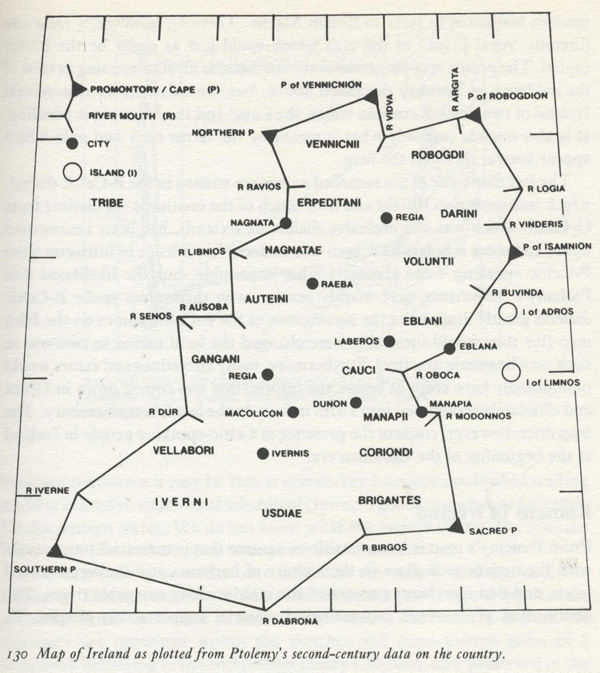Roman
Roman Figurine from the Boyne Valley
A small Roman copper alloy figure was found in the River Boyne, Co. Meath.
By Rachel O'Byrne
Copper alloy figurine (height approx. 8cm) of a youthful male wearing a knee length tunic with sash, possible boots and a wreath on his head. The left arm is held out in front of his body and the right arm extends above his head but is fractured at the wrist.
The museum register entry for this object reads:
“P0752. Roman draped figure found in the Boyne near Navan - Presented to Dr. Petrie by Mr. Wakeman.”
The object was listed in the George Petrie Catalogue compiled by the antiquarian William Wakeman in 1867. With the work of the Inventory Project, the object was identified in the Museum crypt and matched with its Petrie catalogue record.
Who does the figure represent?
The figurine most likely represents Lar (plural Lares).
Lares were important deities for households in the Roman Empire. They were believed to protect the household inhabitants within their household boundaries. They were placed at the table or in shrines, (Lararium) often in pairs, during meals and family events. Offerings and prayers were made by family members to the Lares. Others were also placed at focal points to be deities of entire farmlands, protecting broader areas and encouraging good crops.
Lar figures held objects that would have been used for ceremonial acts or libation. This figure no longer holds his former possessions but we know based on depictions of other Lar figures that in his left arm he would have held a patera, a small shallow ceramic dish or a cornucopia, a horn containing an abundance of produce. In the raised right arm the he would have held a Rhyton, a container from which liquid would have been poured during the act of libation.
Importance within the collection
The extent of the Roman influence in Ireland has long been debated. The Classical texts imply that due to Ireland’s peripheral location, it was not a desirable destination. However the archaeological record has been helping to shed more light on the actual events of this time. Roman objects discovered in Irish contexts exist but they are relatively uncommon, and subsequently the finding of Roman objects generates great interest. The work of the Inventory Project has resulted in an increased identification of Roman material found in Irish contexts. This has led to a greater understanding of Ireland’s connections to the Roman Empire during the Iron Age. This object is one such specimen.
Significance of the River Boyne
This figurine was discovered in the River Boyne, near Navan, Co. Meath. The river meanders past important archaeological sites such as Tara, Newgrange and Knowth. The discovery of the object in this area of rich archaeological and mythical heritage suggests significance. In Irish mythology the river was thought to be divine and born of the Goddess Boann. This belief in the divinity of rivers was also held by the Romans. The significance of the Boyne can be further exemplified by the fact that the river was known in the Roman Empire. Ptolemy included the Boyne on a 2nd century map and called it Buvinda. Further to this, Roman material has been found in nearby contexts including a wealth of Roman goods from both Newgrange and Tara, a bronze ladle from Bohermeen Bog, a Roman brooch and pottery from Randalstown, Co. Meath and further Roman pottery at the Boyne estuary. The discoveries of these objects demonstrate a Roman influence in this region.

Map of Ireland as plotted from Ptolemy's 2nd century data on the island
Ritual deposition
The person who placed the object in its riverine setting is likely to have believed in the sacredness of the river. Rivers acted as boundary markers and as such the placement of the object in the Boyne could also be seen as a ritual boundary deposit. It is also quite possible that they would have understood and valued the intended protective use of the Lar figurine. For these reasons it seems likely the object was intentionally placed in a ceremonial act as either a boundary deposit or as a means of protecting the object’s owner, the inhabitants and rich flowing waters of the Boyne Valley.
Read more…
-
Kelly, E.P. 2002. 'Antiquities from Irish Holy Wells and their wider context', Archaeology Ireland Vol. 16. pp. 24-28.
-
Raftery, B. 1994. Pagan Celtic Ireland: The Enigma of the Irish Iron Age (Thames and Hudson Ltd., London)
-
Thompson, N.L. 2007. Roman Art. A Resource for Educators. The Metropolitan Museum of Art (New York)
Learn more…
This object is not on public display as it is part of the museum’s reserve collections. If you would like to learn more about the Roman world, you can see related objects in the National Museum of Ireland – Archaeology on Kildare Street, Dublin 2.
*With thanks to Eamonn Kelly, Keeper of Irish Antiquities for his comments.
Location:
Roman Figurine from the Boyne Valley is located at:
In Storage
Previous artefact:
Ring Brooch with a Christmas tale
Next artefact:
